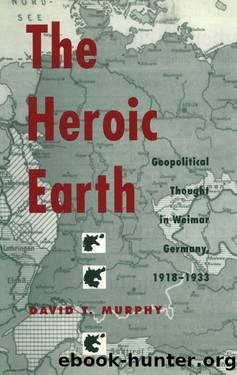The Heroic Earth: Geopolitical Thought in Weimar Germany, 1918-1933 by Murphy David T

Author:Murphy, David T [Murphy, David T]
Language: eng
Format: epub
Publisher: Kent State Univ Pr
Published: 1990-06-01T00:00:00+00:00
In defiance of postwar political reality, therefore, German geographers decided that Lwow, Bratislava, and Sibiu were to remain, for Germans at least, Lemberg, Pressburg, and Hermannstadt. Some cartographers never needed prompting on the issue, of course, particularly those affiliated with conservative nationalist groups. In a famous map from 1924 put out by the Austro-German Volksbund and entitled âIt Ought to Be the Entire Germany!â all the traditional German names are retained. (See fig. 3.) The Volksbund was quartered in the Schloss Bellevue in Berlin where Loeschâs Deutscher Schutzbund had originally been located, and it is safe to assume there were links between the two groups.8 This particular map is a good starting point for a consideration of geopolitical cartography because it presents a microcosm of the stylistic evolution of the field during the Weimar (and Nazi) years. Although the main map holds to fairly standard, âscientificâ conventions of cartographic representation for linguistic and political maps and portrays the natural and human-made features outside as well as within the borders of Germany, it also contains a foreshadowing of the coming geopolitical cartographic style. Displayed in three panels in the lower right section of the sheet are three stark, black-on-white outlines entitled Rumpfdeutschland, Grossdeutschland, and Gesamtdeutschland. The last of these, including all regions where German was the language of the majority of the population, was, of course, the largest, embracing most of central Europe. Both the title of the entire map (a popular slogan of the German Democratic Party in these years) and of the inset captioned âGesamtdeutschlandâ convey unmistakably the message that all the regions shown are, by rights, German.9
Geopolitical cartographers over the decade became highly skilled in the use of linguistic and cartographic symbols to convert seemingly scientific maps into sophisticated political messages. The most prominent geopolitical cartographer, Arnold Hillen Ziegfeld, argued that geopolitics could help German students to envision the world anew, and called upon cartographers to meet their needs: âThe desire to encompass the play of historical, political, economic, and cultural forces behind appearances has led to liberation and repudiation of the previously dominant fundamental guidelines to reproduce only the quantifiable, the so-called reality.⦠Today it is recognized that the desire to use maps as a means of creative representation is justified.â10 Ziegfeld played an important role in what he described as the âstruggle for a new world image.â11 He was the cartographer who drew Penckâs trendsetting map of the German cultural soil (see fig. 1), and his maps appeared frequently in geopolitical and volkish books and periodicals throughout the period.
Ziegfeldâs maps made a graphic case for German expansion in central Europe on grounds of economics, culture, and security. His map entitled âGerman Culture and Its Effect,â which appeared on the cover of Volk und Reich in 1928, typified his style. (See fig. 4.) The dense black mass of the coterminous German Reich and its appanage in East Prussia spills over into most of the regions outside the borders of Germany through the use of crosshatching and other shadings.
Download
This site does not store any files on its server. We only index and link to content provided by other sites. Please contact the content providers to delete copyright contents if any and email us, we'll remove relevant links or contents immediately.
| Anthropology | Archaeology |
| Philosophy | Politics & Government |
| Social Sciences | Sociology |
| Women's Studies |
The Secret History by Donna Tartt(16621)
The Social Justice Warrior Handbook by Lisa De Pasquale(11489)
Thirteen Reasons Why by Jay Asher(7788)
This Is How You Lose Her by Junot Diaz(5769)
Weapons of Math Destruction by Cathy O'Neil(5036)
Zero to One by Peter Thiel(4824)
The Myth of the Strong Leader by Archie Brown(4789)
Promise Me, Dad by Joe Biden(4447)
Beartown by Fredrik Backman(4415)
Stone's Rules by Roger Stone(4415)
How Democracies Die by Steven Levitsky & Daniel Ziblatt(4398)
The Fire Next Time by James Baldwin(4342)
100 Deadly Skills by Clint Emerson(4076)
A Higher Loyalty: Truth, Lies, and Leadership by James Comey(4032)
Rise and Kill First by Ronen Bergman(4012)
The David Icke Guide to the Global Conspiracy (and how to end it) by David Icke(3881)
The Farm by Tom Rob Smith(3872)
Secrecy World by Jake Bernstein(3782)
The Doomsday Machine by Daniel Ellsberg(3730)
